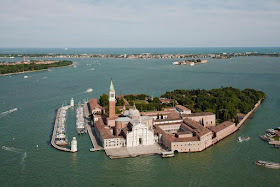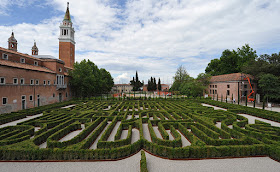(Venice, Italy) To pick a Flashback Summer! post, I've gone all the way back to the beginning of this blog, to March 16, 2008, more than eight years ago. At that point in time, the terrorists were Al-Qaeda, and Barack Obama and Hillary Clinton were still slugging it out -- the Democratic National Convention would not take place until August 25, 2008, the day
after the Olympics in Beijing concluded, and a week
before the Republican National Convention -- which selected John McCain and Sarah Palin(!).
I remember I wrote it because the world seemed to have lost its way, and to remind ourselves that once there were times when men actually were knights who really did conquer castles. I was still finding the right voice, so it's a little gangly, but the essence remains the same.
Oh, the Glory Days when Knights rode the earth! Yesterday, I was over
in Campo Santi Giovanni and Paolo, which is chock-full of all sorts of
fascinating structures. I went with new arrivals in town from England; I
wanted to see Venice through fresh eyes. By taking a little tour with
them, it was easier for me to see the wonders of Venice by watching
their reaction, and appreciate, again, how many miracles we have here.
Just one masterpiece would be enough to provide the income for a entire
town anywhere else; the problem with Venice is that we have so many
masterpieces. My hope is to show you how magnificent and powerful this
culture once was -- and still is -- if you know how to scratch beneath
the surface.
 |
| Italian Knight by Robert Wydock from Woodcarver Illustrated |
I'm not going to tell you everything we
did, because it was so wonderful we must keep some things secret or the
next thing you know there will be tourists in the bathtub. But there
is a magnificent bronze statue of Bartolomeo Colleoni right in plain
sight. I think my uncle may have used it as his inspiration for his
black walnut wood sculpture, Italian Knight, but I have to ask him to be sure.
Born
in 1400 in the countryside outside of Bergamo, which was then part of the Duchy of Milan, Bartolomeo Colleoni was a
professional condottiero, or mercenary soldier, for the Venetian
Republic from 1448 until his death in 1475. He actually started working
for them many years before, in 1432, but he was always switching sides.

Colleoni was the son of a nobleman, Paolo, who was killed by his cousins
after he conquered the Trezzo castle, and the Duke of Milan, Filippo
Maria Visconti, had him assassinated -- since, after all, it was his
castle. The Colleoni were Guelphs, which means they supported the Pope
against the Emperor. (The eternal war seems to be: are you for or
against the Pope? Are you for or against the Empire? Which Pope? Which
Empire? Who is your God? Is your God the same as my God? If there is one
God, then who is his Son? Is there a even a God at all, or are there a
bunch of gods up on Mt. Olympus playing men against each other like
human chess pieces?) Everyone was always changing sides; towns changed
sides; families changed sides, etc. Sometimes the Black chess pieces
were winning, and sometimes the White; when the game was over, they set
up the chess pieces and started all over again, sometimes switching
colors.
So, if we think it terms of chess, we can
understand a little bit more about Italy. If you take someone's castle
away, they are going to be a bit perturbed. Can you imagine such a thing
in real life? A Knight actually, physically takes away a Duke's actual,
physical castle. Ah, those were the days!
And then we
have Venice, a Republic which had different rules than the
city-states. The Venetian nobility created their own rules, which we
will examine another time. Of course, they still had to obey the various
Emperors and Popes in their fashion, but since there were/are so wily,
they were always playing tricks on the authorities:) The Venetians were
playing a different game, which often intercepted that other chess game.
So,
all those city-states were constantly fighting with each other, trying
to conquer each other in the name of the Pope or the Emperor or
God-knows-who. Venice didn't care much about either the Pope or the
Emperor; they were an entity unto themselves, much like today. At one
time the Venetian Republic did reach all the way to Bergamo -- I would
imagine that Colleoni had a bit to do with that. Colleoni took a lot of
towns away from the Milanese on behalf of Venice. Colleoni knew how to
play both games, and that was valuable.
Colleoni was born right into
the thick of it. In this case, we can see that, perhaps, Colleoni had
personal reasons for changing sides: the Duke of Milan had killed his
father. The point is that he was not Venetian, but he worked for the
Venetians. Anyway, after Venice and Milan
made peace 1441, he went back to Milan and joined the Milanese in 1443. But the cunning Duke did not trust him and threw Colleoni in
prison, where he remained until the Duke died in 1447. I am quite sure that
Colleoni was not happy about that, so he went back to the Venetians. In
return for this, he expected some pretty decent perks -- he wanted to be
the captain-general. The Venetians did not grant him this privilege, so
he went back again to Milan, until the Venetians finally caved in and
made him captain-general for life.
 To
really grasp how powerful Colleoni was, let us look at what he
left behind: the magnificent equestrian monument here in Venice,
modeled in 1481 by Leonardo da Vinci's teacher, Andrea Verrocchio, and
an entire church/mausoleum in Bergamo, the Cappella Colleoni (Colleoni
Chapel), where his remains are.
To
really grasp how powerful Colleoni was, let us look at what he
left behind: the magnificent equestrian monument here in Venice,
modeled in 1481 by Leonardo da Vinci's teacher, Andrea Verrocchio, and
an entire church/mausoleum in Bergamo, the Cappella Colleoni (Colleoni
Chapel), where his remains are.
First he asked nicely if he could have
the sacristy of the Church of Santa Maria Maggiore for his tomb, but the
officials said no. So, he conquered the church, destroyed the church, and built a new
one, which he turned into a personal mausoleum for himself and his beloved
daughter, Medea (what kind of man is going to name his daughter,
"Medea?"). Although this was back in the 1400s, in terms of history, it
was not that long ago, so you can only imagine how much the level of life has changed as we all sit behind our computers and pretend we are cyber knights with cyber castles.
Colleoni
was such a strategist that in order to get the equestrian monument
built, in his will he left the Venetians a fortune -- 216,000 gold and
silver ducats, as well as land and property on the condition that they
"build a monument in his honor outside of San Marco." The Venetians
needed the money, but it was against Venetian rules to have any statues
built to individuals in Piazza San Marco. (Remember, Venice was an
oligarchy, a group of noble, very rich, powerful families, that
constantly monitored each other. One family could not be more powerful
than another, and certainly no guy from Bergamo was going to get a
statue in Piazza San Marco.)
The Venetians, clever as they are, found a solution to this problem. Since Colleoni's will said "outside of San Marco," not Piazza San Marco, they built the statue outside the Scuola Grande
of San Marco! Ha! The Scuola Grande of San Marco is now our present-day
hospital, and you can see what a beautiful job the non-profit
organization, Save Venice, did to restore the facade the next time you
are over in Campo Santi Giovanni and Paolo. Have a look with your own eyes
and imagine what kind of men once walked upon the very space you are
standing in another dimension of time.
By the way, in Italian, the word "coglioni," which sounds like "Colleoni" is slang for testicles, of which Colleoni had three. The story goes that he was so proud of this that he had three balls on his coat of arms.
If you would like to receive Venetian Cat - The Venice Blog in your mailbox, please subscribe.
Ciao from Venezia,
Cat Bauer
Venetian Cat - The Venice Blog
























